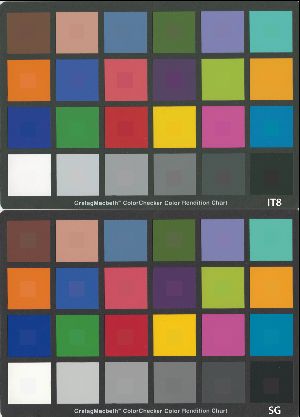articles/Review/epsonexpression-page2
EPSON Expression XL & XL Pro - part 2 of 1 2 3
by Mike McNamee Published

Comparing the two Macbeth Charts gives a visual comparison of the scan accuracy. The only real loser from the SG Chart is the dark skin patch. Overall though these are very good data, about as good as you can expect from a scanner of any quality.
The document sizes are:
Flat Bed: 12.2x17.2 inches (310x437mm)
Auto Document Feeder (optional): 11.7x17.0 inches (297x432mm)
Transparency Unit (XL Pro only): 12.2x16.5 inches (309x420mm)
Scan resolution is 2,400dpi optical. The transparency scanner is supplied with holders up to 5x4 inch, but scanning is available over the 309x420mm area. Scanning up to 4,800dpi is available via a sub-scanning which moves the carriage.
The scanner is quiet and fast in operation (a full A3 scan takes 33 seconds at 300dpi and just 14 seconds at 150dpi) and, once the bulb is warmed up, there is minimal fall-off of illumination around the edges. The lid is heavy because it incorporates the transparency scanning unit, but the hinges are solidly engineered and clever damping ensures that the lid stays up when lifted with no danger of dropping it back down accidentally - it actually needs gently pushing back into place. The only disadvantage of the lid is that it cannot be removed, so that scanning larger artwork in sections and stitching together is limited to about A1. This is unlikely to be a problem for me as I currently print up to A2 on an Epson 4000 with plans for A1 printing in the near future with an Epson 7880.
The Expression 10000XL offers a substantial improvement over my current A3 scanner which has proved clunky in use and has been poor at differentiating pale shades of grey, tending to bleach out the finer details. The Epson has no difficulty in handling these subtle shades, including the pale greys on a white background found in the white petals on Margaret Stevens' painting of the lily (see the detailed discussion elsewhere in this feature - Ed).
This is a reassuringly solid and reliable device which is stable in use and offers high-quality A3 scanning, happily importing into Photoshop the finest details and delicate shades of colour that I have struggled unsuccessfully to manage so far. I want one! (He's now got one - Ed.!)
Colour Performance (MMcN)
Such was the fanatical quest to optimise the scans from both the XL and the V750 that the review turned into an analysis of the merits of using either the Macbeth SG target or the more common IT8 target. McNamee has long harboured a suspicion that the IT8 target was not quite up to the standard of the Macbeth Colour Checker SG, despite earlier remarks about the differences between the SG and the 24-swatch Colour Checker (CC24). We ended up taking the actual CC24 we were using and building that data into a bespoke spread sheet to eliminate errors in the accuracy of the chart itself. In summary, the profile built using the IT8 target was inferior in all departments apart from the density of the darker colours which it computed more accurately (in the lightness component only). Crucially, we found on two separate tests that the IT8 was creating non-neutral neutral tones (!), that is the profiled greys were up to 5 Lab points green. IT8 targets are made from photographic paper prints and often shift pink in tungsten light. We are suspicious that the pink-biased metamerism is detected by the fluorescent tube of the scanner and then over-corrected towards the complementary colour, that is, towards green.
When correctly profiled, the XL produced very accurate colour across the whole area of the platen. We could just detect a variation from one side to the other but only on one or two swatches, it was essentially inside the measurement error of the Photoshop colour picker - that is the value should have been 50% Lab L and sometimes flicked to 51%, in other words trivial!The average error across the whole chart was 2.00 ΔE2000. By coincidence, one of the largest errors became the foliage green (6.8 ΔE Lab/3.73 ΔE2000). The largest was the dark skin swatch which lost out with a high error in saturation. Bear in mind though we are talking about small errors and looking at fine differences. Overall this was a top-rate performance from a scanner across the expanse of an A3 original. It is, however, unrealistic to expect to achieve the level of precision we were seeking for our reproduction without hand tweaking. To some extent this is a classical example of where the craft scores over the science - the science got us as close as it could, but still required manual intervention to proof out a final that was beyond reproach (and, it has to be said, of a quality that would go unacknowledged by many viewers). Perhaps an incident that occurred during the trials tells the full story. We spent some time carefully measuring a print and making copious notes only to discover, near the end of the process, that we were not working on the original, we had picked up a proof!
Please Note:
There is more than one page for this Article.
You are currently on page 2
- EPSON Expression XL & XL Pro page 1
- EPSON Expression XL & XL Pro page 2
- EPSON Expression XL & XL Pro page 3
1st Published
last update 09/12/2022 14:53:55
More Review Articles
There are 31 days to get ready for The Society of Photographers Convention and Trade Show at The Novotel London West, Hammersmith ...
which starts on Wednesday 14th January 2026




